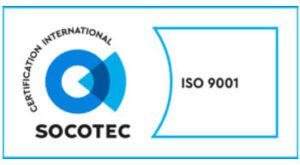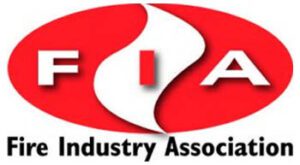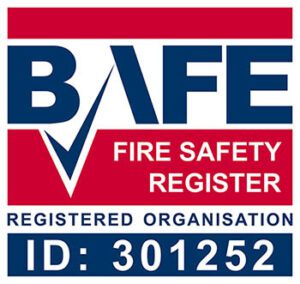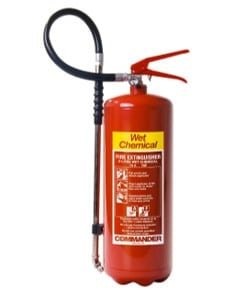Wet chemical extinguishers are one of the less well-known extinguisher types.
If you’re unsure what fire extinguisher for cooking oil is an appropriate choice for a commercial kitchen, then here’s the answer – wet chemical fire extinguishers are the only extinguishers recommended for use with cooking oil fires and are essential safety kits for professional kitchens.
Read about more fire extinguisher types: foam fire extinguishers, dry powder fire extinguishers, CO2 fire extinguishers, water fire extinguishers.
We explain all in our simple guide.
Also known as:
• ‘Class F’ fire extinguishers
• ‘Class ABF’ fire extinguishers – some versions only
Wet chemical fire extinguisher uses:
• Fires involving cooking oils and fats, such as lard, olive oil, butter and vegetable oil (‘class F’ fires)
• Fires involving flammable solids, such as paper, wood, and textiles (‘class A’ fires)
Some wet chemical fire extinguishers are also cleared for use on class B fires – those involving flammable liquids, such as petrol, diesel, and paint. Check the label or ask your fire safety professional before using wet chemical extinguishers on this type of fire.
Do not use wet chemical fire extinguishers for:
• Fires involving flammable liquids (‘class B’ fires) UNLESS they are specifically cleared for this use
• Fires involving flammable gases, such as methane and butane (‘class C’ fires)
• Electrical fires
How to identify a wet chemical fire extinguisher:
• YELLOW coloured label stating ‘Wet Chemical’
• Has a longer than usual hose with a ‘lance’ attachment
• Should be identified by an extinguisher ID sign fixed nearby – ‘Wet Chemical Extinguisher’
Sizes of wet chemical fire extinguisher available:
• 2 litre
• 3 litre
• 6 litre
How wet chemical extinguishers work:
The ‘chemical’ element of wet chemical fire extinguishers is potassium.
Potassium salts are sprayed out as a fine mist (gently, so as not to spread the burning oil or fat), and these react to create a soapy film on the surface of the substance on fire.
This smothers the fire, with the added benefit that the mist also creates a cooling effect.
Pros and Cons of wet chemical fire extinguishers:
Pros: the only fire extinguisher suitable for use with cooking fat and oil fires.
Cons: can produce toxic fumes areas should be ventilated if a wet chemical extinguisher has been used.
Who needs wet chemical fire extinguishers?:
If you’re wondering – which extinguisher should you use on a burning chip pan? The answer is a wet chemical fire extinguisher. In fact, any premises with a professional kitchen or deep fat fryer should have a wet chemical fire extinguisher:
• Restaurants
• Fish and chip shops
• Burger bars
• Hotel kitchens
These types of business generally also need the ‘standard pair’ of a foam extinguisher and a CO2 extinguisher, so that ALL fire risks are covered.
Learn about fire extinguisher types, or fire extinguisher servicing.
Read more about extinguisher colours.
How to use a wet chemical fire extinguisher:
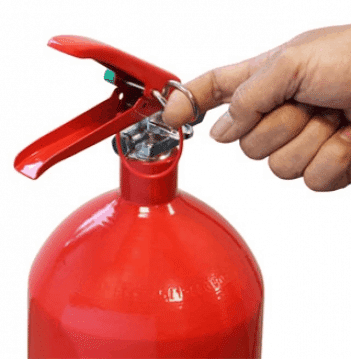
Wet chemical fire extinguishers need to be used very carefully, to avoid splashing burning fat or oil onto surrounding areas.
Using the extinguisher:
• First remove the safety pin to break the anti-tamper seal and stand well back from the fire
• Turn off the source of the heat if safe to do so – e.g. a chip pan or stove
• Hold the lance at arm’s length well above the fire, with the nozzle at least 1 metre away from the flames
• Spray gently in slow, circular movements, allowing the foam to settle on the surface of the fire
• Use the entire contents of the extinguisher to prevent the fire re-igniting
If you think you need wet chemical fire extinguishers, or if you are not sure what you need, just get in touch with our friendly team by calling 0800 157 1113, or emailing [email protected].
They will be able to arrange a free survey visit for you from a BAFE registered extinguisher engineer.
All of our extinguishers come with a 5 year guarantee, and we fit and commission them for you for free.
Contact Us
